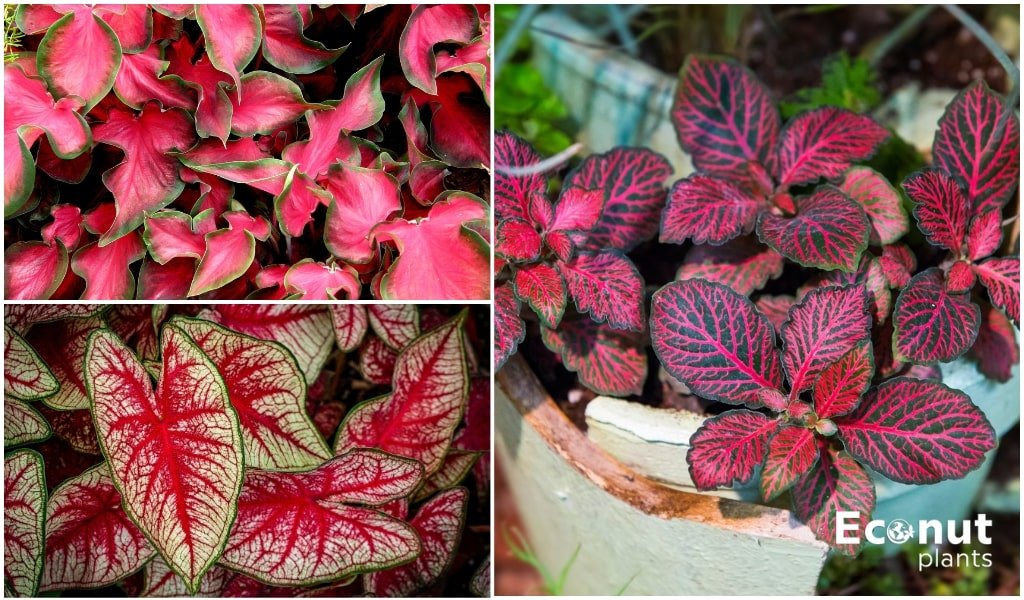Red-leaf plants give any home’s interior striking scarlet, burgundy, maroon, and deep pink tones. Bright red and green leafy plants liven up spaces and give the design a cozy feel.
This is a guide to some of the most striking red-leaf plants available. It includes excellent suggestions on where to grow these vibrant houseplants and descriptions of their foliage.
1. Hippo Red Polka Dot Plant
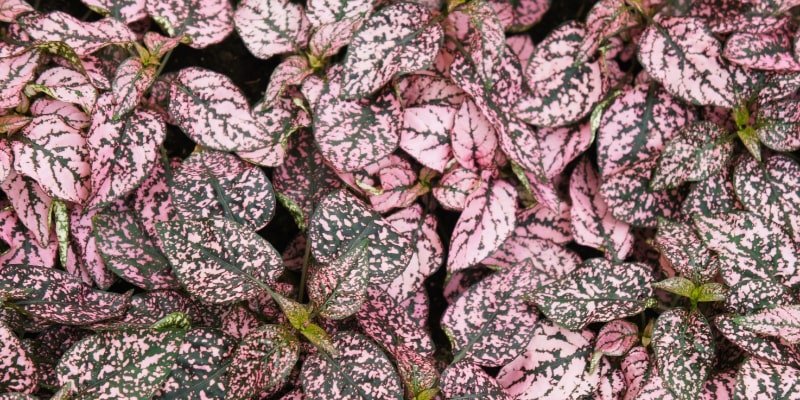 Scientific Name: Hypoestes Phyllostachya
Scientific Name: Hypoestes Phyllostachya
Plant Type: Annual
Plant Size: 16-22
Water Needs: Moderate
Sun Exposure: Full Shade to Partial Shade
Geographic Origin: Madagascar
The Hippo Red Polka Dot Plant leaves are black with red and green specks. Due to its voluminous leaves, it is frequently cultivated as filler in container gardens.
There is no need to deadhead these low-maintenance plants. Though they take a little longer to multiply than other plants, polka-dot plants are simple to multiply. They must be positioned appropriately to ensure adequate airflow.
2. ‘Juanita’ Mosaic Plant
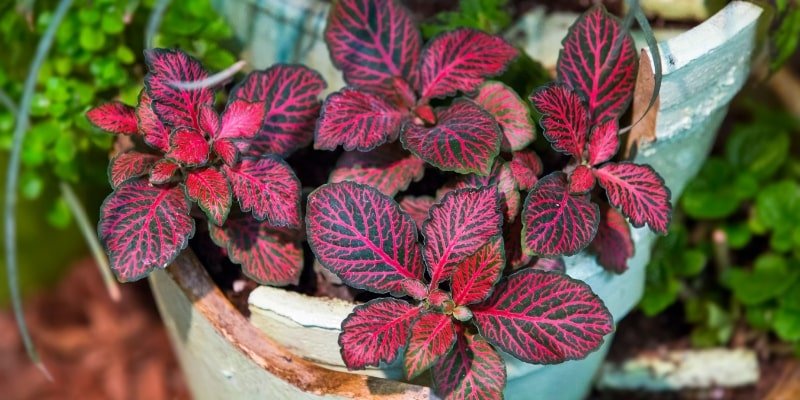 Scientific Name: Fittonia albivenis ‘Juanita’
Scientific Name: Fittonia albivenis ‘Juanita’
Plant Type: Herbaceous Perennial, Creeper
Plant Size: 12
Water Needs: Moderate to Heavy
Sun Exposure: Partial/Full Shade
Geographic Origin: Brazil, Bolivia
Red veins on evergreen foliage give these leaves their red look. Both the plant and its leaves remain relatively modest. These plants are ideal to add some green and red leaves to a shaded location.
It must be loamy soil with good drainage. Maintain a temperature of 65 °F or above. They fare well in environments with excessive humidity.
3. Lilinoe Cordyline
 Scientific Name: Cordyline Fruticosa ‘Lilinoe’
Scientific Name: Cordyline Fruticosa ‘Lilinoe’
Plant Type: Perennial Shrub
Plant Size: 4-6
Water Needs: Moderate
Sun Exposure: Full Sun to Partial Shade
Geographic Origin: New Guinea
Another plant with medicinal properties is the lily variety. Its long, red leaves are also used as headdresses and ornamental garments.
Use loam and high-quality compost for the soil. Put your finger in the soil to check the moisture content, as root rot is a serious problem.
4. Mammy Red
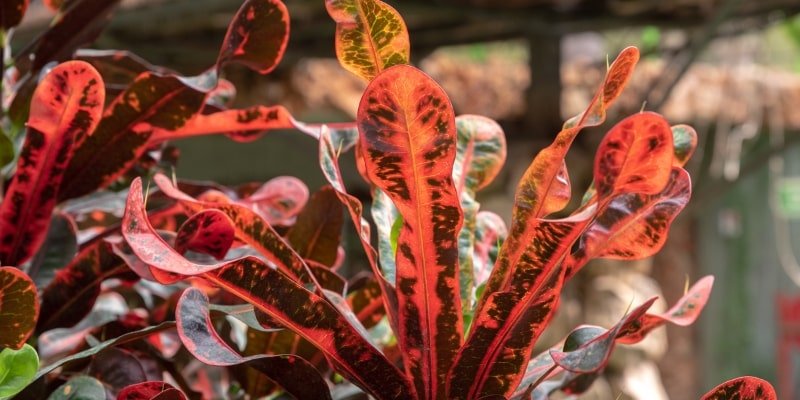 Scientific Name: Codiaeum Variegatum
Scientific Name: Codiaeum Variegatum
Plant Type: Evergreen Monoecious Shrub
Plant Size: 42
Water Needs: Moderate
Sun Exposure: Full Sun
Geographic Origin: Indonesia, Malaysia, Australia
This type of plant, not fried bread crumbs, is what people mean when they ask you, “Do you like crotons?” as they approach you. The long, curled leaves have orange, yellow, green, and red patterns, which give the plant a flaming appearance.
These plants prefer warm temperatures, while lows of 60°F cause them to react poorly. Maintain a humid but not overly wet soil with loamy drainage.
5. ‘Omaha Beefsteak’ Begonia
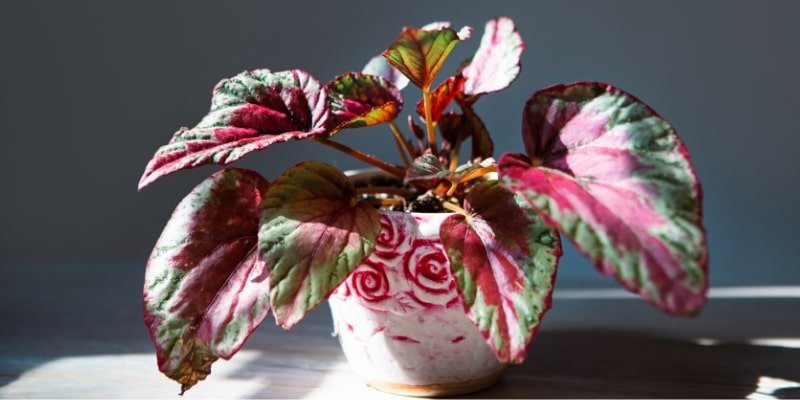 Scientific Name: Begonia Rex-Cultorum
Scientific Name: Begonia Rex-Cultorum
Plant Type: Evergreen Perennial
Plant Size: 6-12
Water Needs: Moderate to Heavy
Sun Exposure: Full Sun to Partial Sun
Geographic Origin: North Eastern India to China
You might have been staring at an Omaha Beefsteak Begonia, a common variety of begonia you’ll find in many homes if someone says, “That was my grandmother’s plant.”
You can use hanging planters or pots to hold these houseplants, require very quickly draining soil. Combine vermiculite or pumice, aged compost, and potting soil. Give lots of water, but make sure that any standing water is prevented by adequate drainage. Make sure the plant is in an area with bright, indirect light.
6. Red Anjamani
 Scientific Name: Aglaonema
Scientific Name: Aglaonema
Plant Type: Perennial Herb
Plant Size: 36
Water Needs: Moderate to Heavy
Sun Exposure: Partial Shade
Geographic Origin: Asian Subtropics and Tropics
The ovate, crimson-to-pink leaves of the crimson Anjamani shrub are lovely. This plant is ideal for giving a light-colored space a pop of colour. Avoid direct sunlight, although plenty of indirect light is perfect for these plants.
Don’t let the soil dry out; water more in the summer, and avoid overhead irrigation. Pick soil and a pot that drains properly. If you reside in a dry climate, mist the leaves with water to imitate dampness.
7. ‘Red Log’ Peperomia
 Scientific Name: Peperomia Verticillata
Scientific Name: Peperomia Verticillata
Plant Type: Succulent Herb
Plant Size: 12
Water Needs: Low
Sun Exposure: Full Sun to Partial Shade
Geographic Origin: Bolivia
This plant appears rather hairy, as the Latin name Verticillata suggests. The green tips of the leaves have red undersides.
Because this plant is succulent, it is easy to overwater it. Use loamy soil. It’s not too difficult to care for, just like most Peperomia.
8. Red Moon Cactus
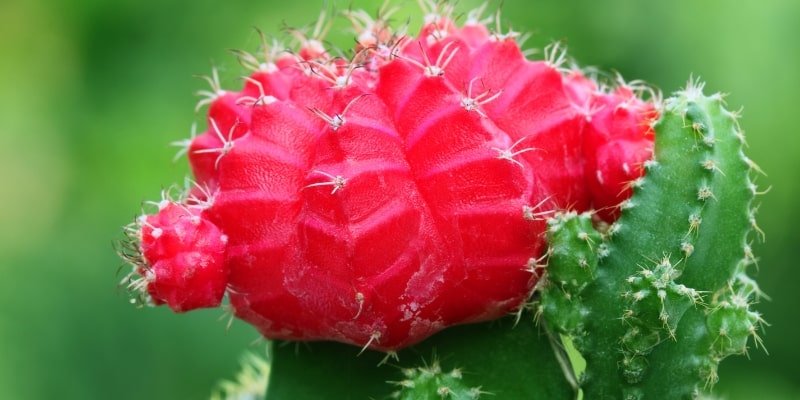 Scientific Name: Gymnocalycium mihanovichii
Scientific Name: Gymnocalycium mihanovichii
Plant Type: Perennial Cactus
Plant Size: 6
Water Needs: Very Light
Sun Exposure: Full Sun to Partial Shade
Geographic Origin: Northeast Argentina, Brazil
A lack of chlorophyll causes this Moon Cactus cultivar’s vivid red hue. Consider getting a red moon cactus for your window sill plant.
Apply more water only when you think the soil is arid. Use well-draining soil to avoid standing water around a cactus. Since direct, continuous sunlight burns the light bulb, pick a window that receives morning light.
9. Ruby Ficus
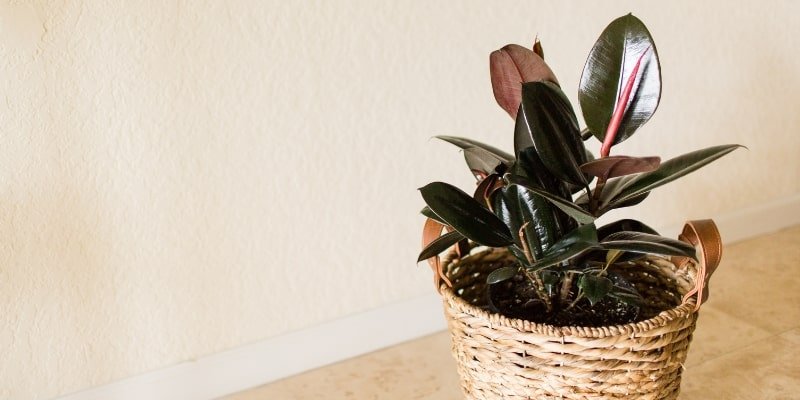 Scientific Name: Ficus elastica ‘Ruby’
Scientific Name: Ficus elastica ‘Ruby’
Plant Type: Tropical Evergreen Tree
Plant Size: 6-10
Water Needs: Moderate
Sun Exposure: Bright, Indirect Light
Geographic Origin: India and Malaysia
Any home will undoubtedly spark conversation about the Ruby Ficus’ rose-coloured foliage. The oblong leaves of this houseplant have striking markings in shades of crimson, dark pink, and cream. Variegated Rubber Tree is another name for them.
To maintain its red colour, plant your Ruby Ficus in an area with lots of bright, indirect light. Different versions differ in terms of darkness.
10. Siam Aurora
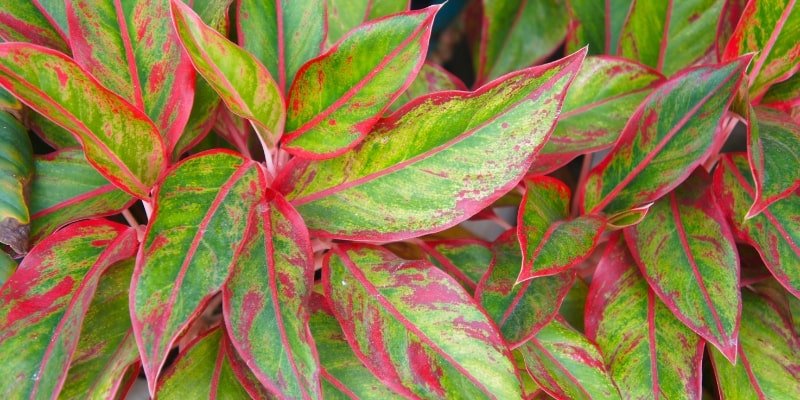 Scientific Name: Aglaonema
Scientific Name: Aglaonema
Plant Type: Perennial Herb
Plant Size: 36
Water Needs: Moderate
Sun Exposure: Partial Shade
Geographic Origin: Asia
Chinese evergreens are a general term for these plants. Like numerous other species we’ve encountered, there are numerous cultivars available.
The leaves are oval and can grow up to one foot long. They are green, white, and red. As they get older, these plants can develop stalks that resemble trees, much like Yucca.
They thrive in pots but only when planted in moist, perlite- or sand-enriched soil that drains properly.
11. Zanzibar Croton
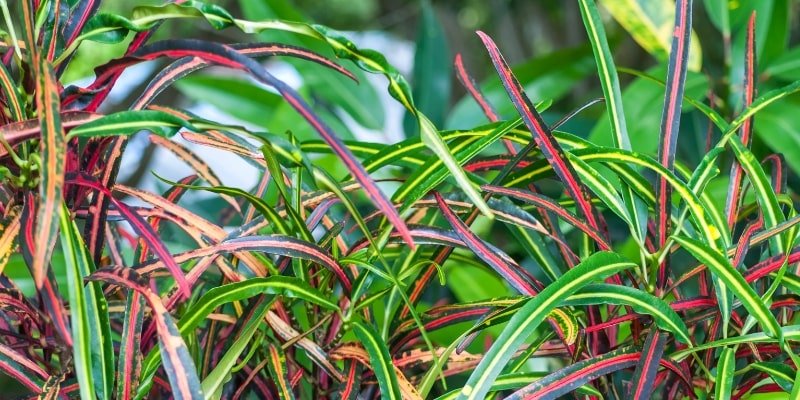 Scientific Name: Codiaeum Variegatum
Scientific Name: Codiaeum Variegatum
Plant Type: Evergreen Shrub
Plant Size: 24-36
Water Needs: Moderate
Sun Exposure: Partial Sun/Shade
Geographic Origin: Australia and Western Pacific Islands
The Zanzibar Croton resembles green, red, and orange grass, unlike other Crotons with lanceolate leaves or similar shapes. These plants like having access to water features. A nearby glass of water or light mistings of water will be beneficial.
Make use of light, drainable soil. Heavy soils cause root rot because they retain more water. Even though this plant prefers high humidity, don’t overwater; keep the soil moist.
12. Aglaonema ‘Valentine’
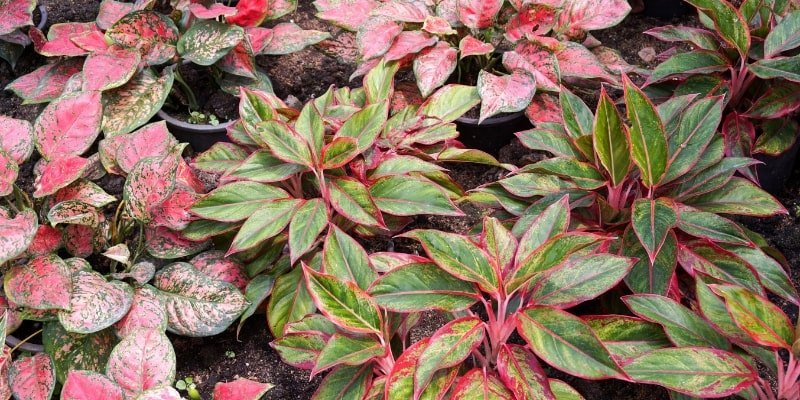 Scientific Name: Aglaonema Commutatum
Scientific Name: Aglaonema Commutatum
Plant Type: Perennial Herb
Geographic Origin: Asia
Plant Size: 36
Water Needs: Moderate
Sun Exposure: Partial Shade
This plant’s leaves are oval, with smooth green margins framing pink and crimson centers punctuated by green splotches. These plants also made NASA’s list of plants that purify the air by removing formaldehyde and benzene pollutants.
Select a bright room free of direct sunlight, just like you would with the other cultivars. These plants all prefer well-draining, wet soil. Keep the temperature from falling below 65ºF.
13. Blushing Bromeliad
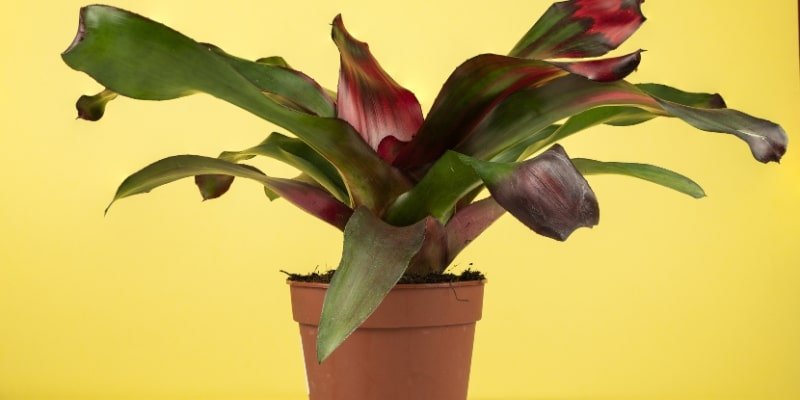 Scientific Name: Neoregelia Carolinae
Scientific Name: Neoregelia Carolinae
Plant Type: Perennial Herb
Plant Size: 12 -18
Water Needs: Moderate to Heavy
Sun Exposure: Full Sun to Partial Shade
Geographic Origin: Brazil
Orchids in the home, bromeliads, typically grow on trees. Still, as houseplants, they look fantastic in bathrooms. People are fond of these houseplants because of the scarlet leaves in the middle.
Not too much direct sunlight is necessary for these plants to flourish, but they do need bright light. Fill the plant’s middle vase with water as you keep the soil moist. Make well-draining soil using one part peat, bark, sand, or perlite.
14. Caladium Bicolor ‘Red Flash’
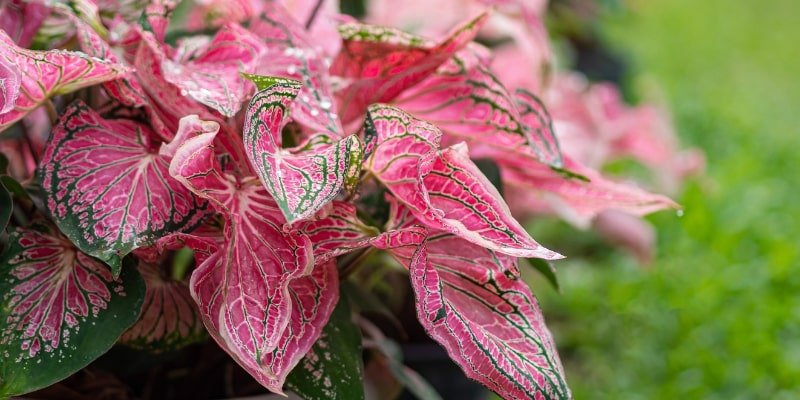 Scientific Name: Caladium Bicolor
Scientific Name: Caladium Bicolor
Plant Type: Tuberous Perennial
Plant Size: 18-30
Water Needs: Moderate to Heavy
Sun Exposure: Partial Sun/Shade
Geographic Origin: Latin America
The Red Flash is distinguished by enormous, heart-shaped leaves with veins that branch out in a star pattern. The leaves begin as crimson in the center and become entirely olive-green around the edges, with specks of pink and red visible farther out.
Use a container appropriate for the size of the plant, as it can grow rather huge. Direct sunlight may scorch the leaves. Instead, allow the plant to add some indirect lighting to a room. Although this plant does not want the soil to dry out between watering, ensure the soil drains properly.
15. Firebrand Cordyline
 Scientific Name: Cordyline Fruticosa Firebrand
Scientific Name: Cordyline Fruticosa Firebrand
Plant Type: Perennial Shrub
Plant Size: 15
Water Needs: Moderate
Sun Exposure: Partial Shade
Geographic Origin: Australia
The leaves of these enormous plants are lance-shaped, with red streaks running along the edges and through the center. Loose soil is better for drainage. As a general guideline, feel for moisture approximately an inch below the soil’s surface.
16. Imperial Red Philodendron
 Scientific Name: Philodendron erubescens
Scientific Name: Philodendron erubescens
Plant Type: Tropical Evergreen
Plant Size: 2-4
Water Needs: Moderate
Sun Exposure: Bright, Indirect Light
Geographic Origin: South America
One of the more well-liked small tropical evergreens nowadays is the imperial philodendron. They tend to grow laterally and do not vine like other philodendrons. The leaves on these also form compact rosettes and are self-heading.
There are some differences between the Imperial Red and the Red Congo, but they are highly similar overall. The reddish-purple leaves of Imperial Reds eventually turn dark green and then burgundy as they mature. They are capable of producing reddish-purple flowers in the wild.
Growing an Imperial Red Philodendron is simple if you can provide warm weather, brilliant shade, steady moisture, and high humidity. These circumstances replicate its natural habitat in the tropics.
17. Nervia
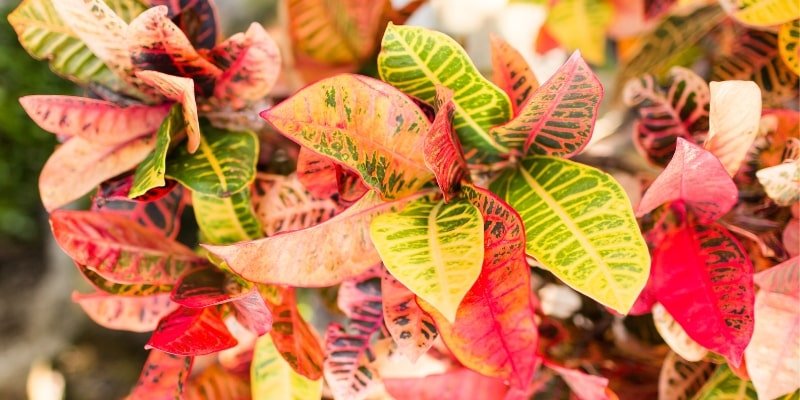 Scientific Name: Codiaeum Variegatum
Scientific Name: Codiaeum Variegatum
Plant Type: Perennial Shrub
Plant Size: 36
Water Needs: Moderate
Sun Exposure: Full Sun to Partial Shade
Geographic Origin: Indonesia, Malaysia
Nerveia plants grow to tremendous heights of three meters in their native habitat, but indoors, they usually reach a height of one meter. The leaves are multicolored and semi-oak. There will be green leaves and maybe scarlet or purple leaves.
Keep the plant in a room with enough ventilation and a temperature that doesn’t drop below 65 degrees. For best results, use a two-part peat mixture with sand or perlite, but any well-draining soil will do. Keep the soil moist during the heat.
18. Philodendron Black Cardinal
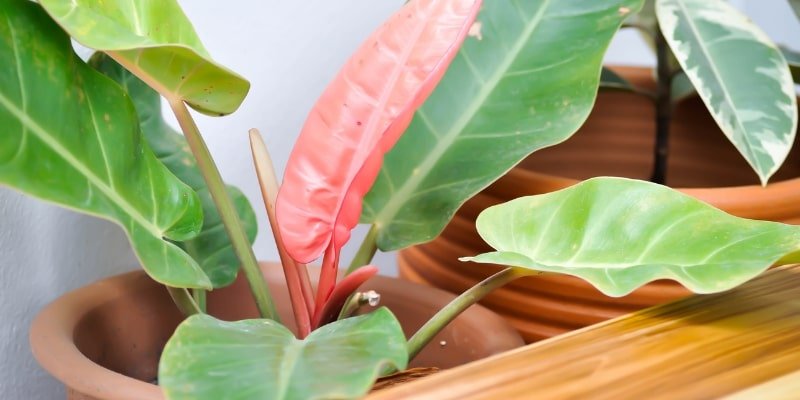 Scientific Name: Philodendron Black Cardinal
Scientific Name: Philodendron Black Cardinal
Plant Type: Perennial Shrub
Plant Size: 2-3
Water Needs: Moderate
Sun Exposure: Partial Shade
Geographic Origin: South America
The Black Cardinal Philodendron is yet another hybrid philodendron on our list. Its deep red leaves grow to a darker shade. The leaves differ from other philodendrons’ characteristic heart-shaped leaves. Furthermore, in contrast to other philodendron species, they self-head.
The black cardinal reaches a very reasonable height of roughly three feet. Aside from its distinctive and lovely colouring, it is an excellent choice for growing inside.
19. ‘Red Kiss’ Begonia
 Scientific Name: Begonia Rex-Cultorum
Scientific Name: Begonia Rex-Cultorum
Plant Type: Evergreen Perennial
Plant Size: 8
Water Needs: Moderate to Heavy
Sun Exposure: Full Sun to Partial Sun
Geographic Origin: North Eastern India to China
The beautiful red and green leaves of Red Kisses alternate with pink centers on fleshy stems. The leaf edges range in colour from black to dark pink. The plant creeps and grows low.
Make use of soil that drains properly and is kept damp. Check to ensure there is no standing water, and let the water pass through. The desired temperature is 50% humidity and 70°F. Apply a water spray as required.
20. Rubra Cordyline
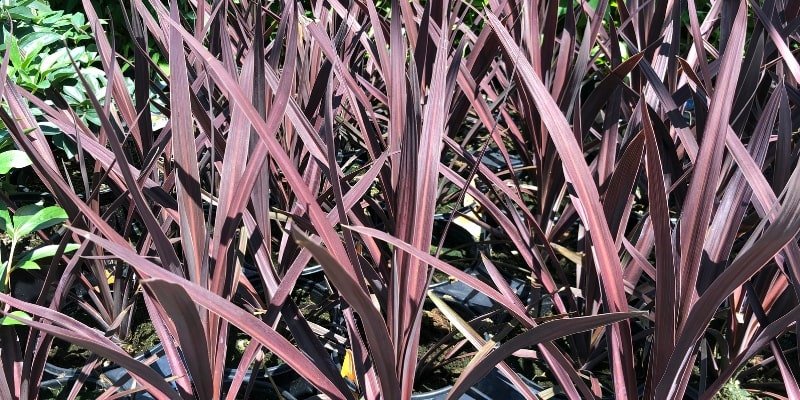 Scientific Name: Cordyline Fruticosa Rubra
Scientific Name: Cordyline Fruticosa Rubra
Plant Type: Perennial Shrub
Plant Size: 10
Water Needs: High
Sun Exposure: Full to Partial Sun
Geographic Origin: Australia
Ti Plant is another term for plants known as Cordyline. In their natural habitat, these plants are significant medicinal herbs.
Give these indoor plants plenty of water. They are from moist regions. Check the soil frequently, and if you detect dampness, stop watering.
21. Saint Andrew’s cross
 Scientific Name: Crassula Capitella
Scientific Name: Crassula Capitella
Plant Type: Succulent
Plant Size: 6
Water Needs: Low
Sun Exposure: Full Sun to Partial Shade
Geographic Origin: Southern Africa
The leaves of this gorgeous succulent plant spin out like propellers and change colour from green to red. It is a branching succulent.
You can use a well-draining container or hanging basket. Since the plant can withstand drought, water it when the soil is dry.
22. Variegated Red Edged Radiator Plant
 Scientific Name: Peperomia Clusiifolia’ Jelly’
Scientific Name: Peperomia Clusiifolia’ Jelly’
Plant Type: Perennial Herb
Plant Size: 6-8
Water Needs: Moderate
Sun Exposure: Full Sun to Partial Shade
Geographic Origin: West Indies & Venezuela
This plant was named “Jelly” because its velvety leaves fascinate visitors. The green tops give way to pink and crimson edges and bottoms.
You can water these plants when the soil seems dry because they store water in their leaves, which helps them withstand dryness.
23. Wandering Jew
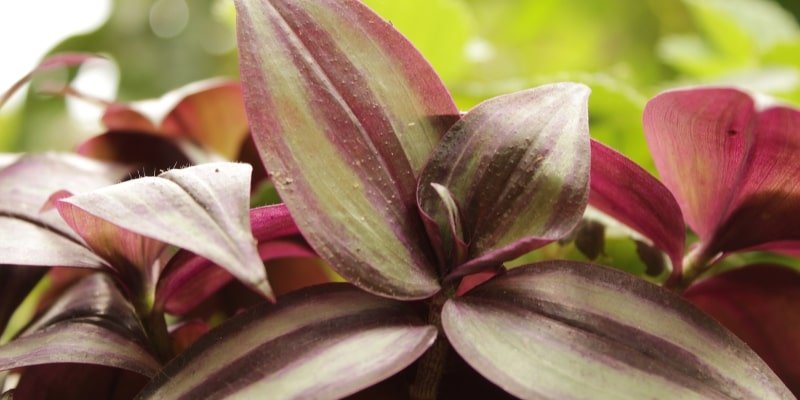 Scientific Name: Tradescantia Zebrina ‘Purpusii’
Scientific Name: Tradescantia Zebrina ‘Purpusii’
Plant Type: Forb
Plant Size: 6 -12
Water Needs: Moderate
Sun Exposure: Partial Shade
Geographic Origin: Mexico
This plant produces gorgeous pink blooms along with variegated green and burgundy leaves. You might use a hanging basket or a container with loamy soil that drains well. Water must only be added if the soil is moist enough, even an inch down.
24. ‘Red Splash Select’
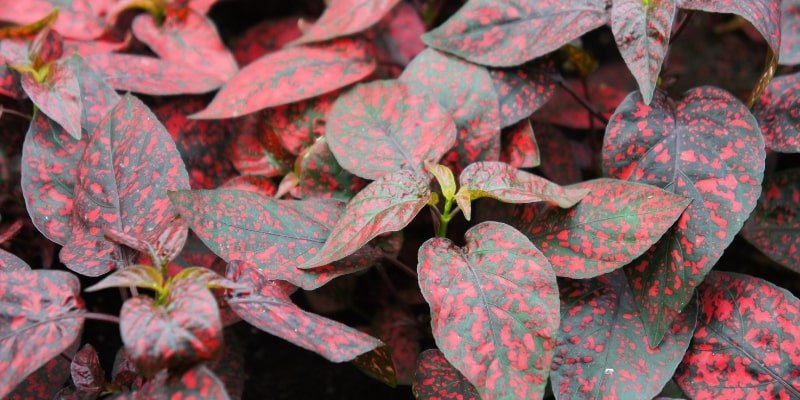 Scientific Name: Hypoestes Phyllostachya
Scientific Name: Hypoestes Phyllostachya
Plant Type: Perennial Herb
Plant Size: 6
Water Needs: Moderate
Sun Exposure: Partial Sun/Shade
Geographic Origin: Madagascar, South Africa
The common name for this plant is Polka Dot Plant. Their leaves are oval and freckled with green. Hanging baskets or containers work well. To keep well-draining soil moist, add adequate water.
25. ‘Revelation Maroon’ Begonia
 Scientific Name: Begonia Rex-Cultorum
Scientific Name: Begonia Rex-Cultorum
Plant Type: Annual
Plant Size: 30
Water Needs: Moderate to Heavy
Sun Exposure: Partial/Full Shade
Geographic Origin: North Eastern India to China
One hybrid trailing plant variety is the Revelation Maroon. According to most descriptions, the leaves are rich crimson in colour, glossy, and have green veins. Hanging baskets or containers work well.
If the soil is drying out, choose a soil type that drains well and is ready to apply a lot of water. Standing water can cause root rot, but the soil must remain moist.
26. ‘Black Star’ Nerve Plant
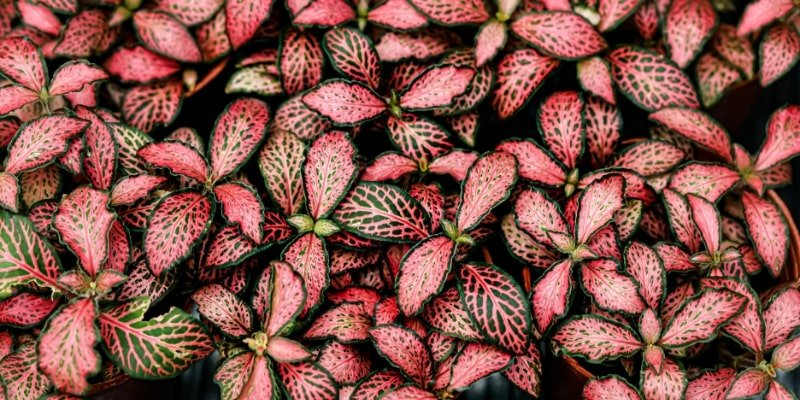 Scientific Name: Fittonia albivenis ‘Black Star’
Scientific Name: Fittonia albivenis ‘Black Star’
Plant Type: Perennial Herb
Plant Size: 12-36
Water Needs: Moderate to Heavy
Sun Exposure: Partial/Full Shade
Geographic Origin: Brazil, Bolivia, Colombia, Ecuador
The characteristic look of this Fittonia cultivar is its variegated evergreen leaves with dark crimson veins. Compared to most other plants, this one grows taller. They add brightness to a dark region of your home and thrive in excessive humidity.
Sufficient watering is necessary to avoid withering. For proper drainage, choose loamy soil that is rich in organic matter.
27. Bush on Fire
 Scientific Name: Codiaeum Variegatum
Scientific Name: Codiaeum Variegatum
Plant Type: Evergreen Shrub
Plant Size: 3
Water Needs: Moderate
Sun Exposure: Partial Sun/Shade
Geographic Origin: Australia and Western Pacific Islands
Very few plants are thoroughly investigated, but the Bush on Fire did. This Croton cultivar needs 50% light and 50% shade to flourish.
“lanceolate” refers to the dark red, lance-shaped leaves with green, yellow, and orange accents that spiral up like flames licking the air. Use well-draining soil. Keep the soil moist but prevent standing water from accumulating to avoid root rot.
28. Caladium ‘Bombshell’
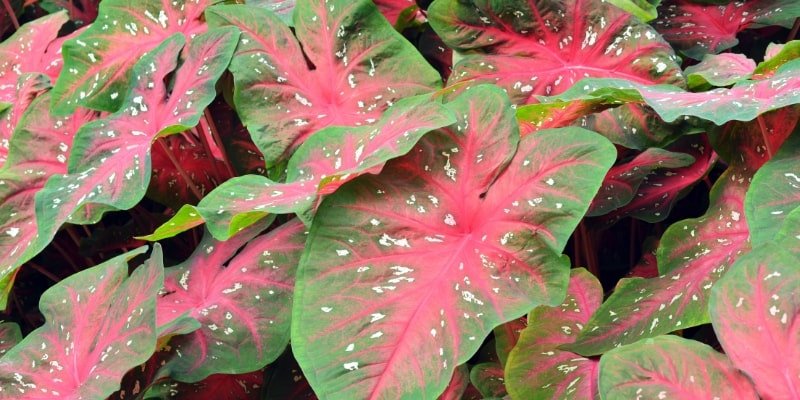 Scientific Name: Caladium Bicolor
Scientific Name: Caladium Bicolor
Plant Type: Tropical Perennial
Plant Size: 10-18
Water Needs: Moderate to Heavy
Sun Exposure: Full Sun to Shade
Geographic Origin: Latin America
The Bombshell has vivid red fancy leaf leaves with smooth green borders, making it ideal for well-lit areas. Planters and containers are suitable for these houseplants.
If you can’t break up the clumps and enable good drainage, use peat moss or coconut coir instead of clay and use well-draining soil. Every month, add fertilizer. These plants, usually not an issue indoors, prefer areas that provide wind protection.
29. Emerald Ripple Red
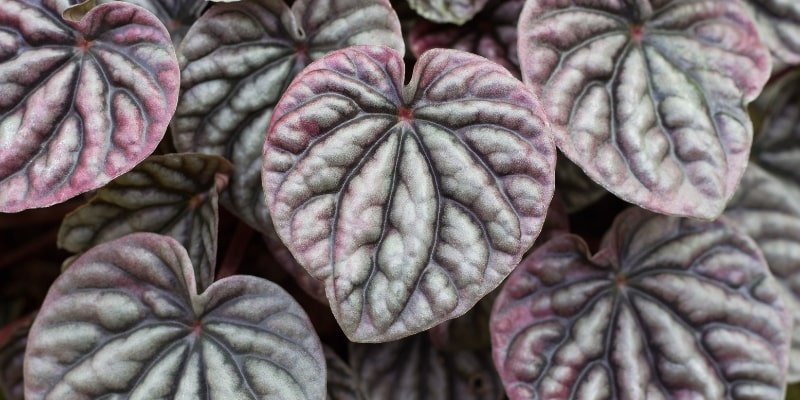 Scientific Name: Peperomia Caperata
Scientific Name: Peperomia Caperata
Plant Type: Perennial Herb
Plant Size: 6-8
Water Needs: Low
Sun Exposure: Partial Shade
Geographic Origin: Brazil
Peperomia plants are commonly referred to as “radiator plants” due to their tendency to spread widely. In the wild, these houseplants grow beneath a tropical canopy and hold onto water. When the soil feels damp, add water sparingly and use loose soil with adequate drainage.
30. Inch Plant ‘Quadricolor’
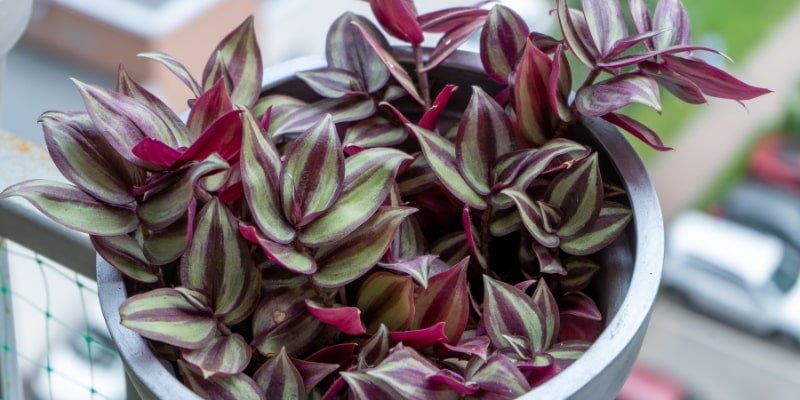 Scientific Name: Tradescantia Zebrina
Scientific Name: Tradescantia Zebrina
Plant Type: Forb
Plant Size: 10
Water Needs: Moderate
Sun Exposure: Partial Shade
Geographic Origin: Mexico
The Quadricolor is a trailing plant with striped purple, pink, silver, and green leaves ideal for ledges. If the soil is getting dry, give it regular watering. Use well-draining soil that keeps standing water out of the soil to avoid root rot.
31. Moses-in-a-Basket
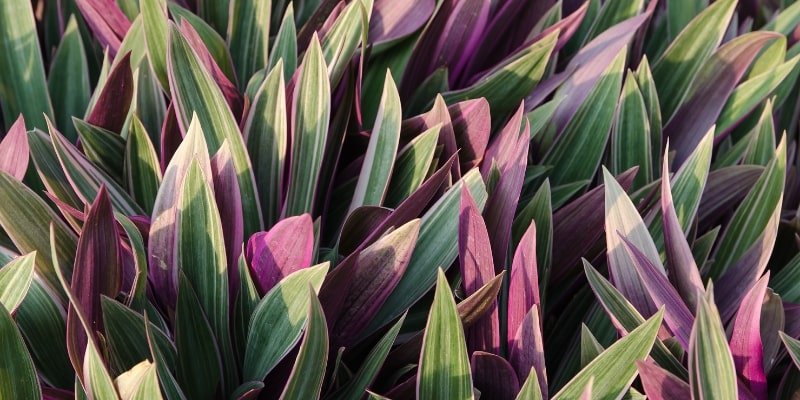 Scientific Name: Tradescantia Spathacea’ Variegated Dwarf’
Scientific Name: Tradescantia Spathacea’ Variegated Dwarf’
Plant Type: Perennial Forb
Plant Size: 12-20
Water Needs: Moderate
Sun Exposure: Partial Shade/Sun
Geographic Origin: Central America
The long leaves on this plant have variegated green and purple hues with pink and magenta highlights. Select loamy soil to avoid the widespread issue of root rot. The roots don’t reach very deep, so you can use a shallow container.
32. Peperomia Rubella
 Scientific Name: Peperomia Rubella
Scientific Name: Peperomia Rubella
Plant Type: Evergreen Perennial
Plant Size: 4-6
Water Needs: Low
Sun Exposure: Partial Sun
Geographic Origin: Jamaica
The undersides of the leaves on this little plant are likewise red. Although they can burn in direct sunlight, they adore brilliant indirect light. Select loamy soil with good drainage. Water the plant in the morning and allow it to dry out during the day.
33. ‘Stained Glass’ Begonia
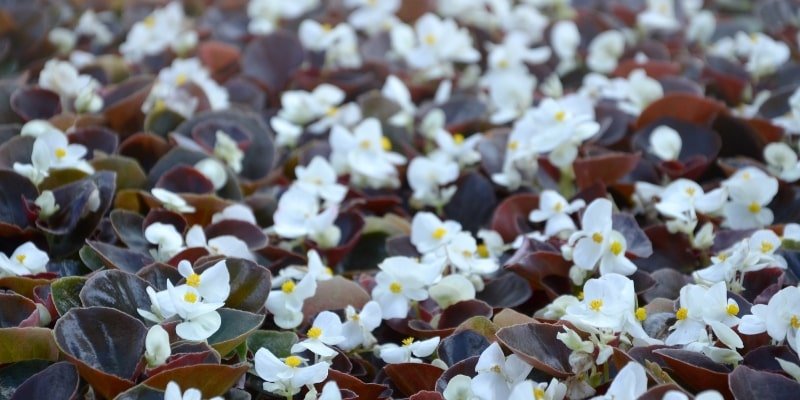 Scientific Name: Begonia’ Cathedral’
Scientific Name: Begonia’ Cathedral’
Plant Type: Evergreen Perennial
Plant Size: 12-18
Water Needs: Moderate to Heavy
Sun Exposure: Partial to Full Shade
Geographic Origin: North Eastern India to China
The beautiful, droopy Stained Glass Begonia has ruby-red leaves with black veins encircled by bluish-white borders. The leaves have wavy edges and resemble little cups.
To provide superior drainage, use soil like peat moss. Although bright spaces are ideal, direct sunshine scorches the leaves. Retain damp soil. You can let the top layer dry down to an inch.
34. ‘Red Anne’ Nerve Plant
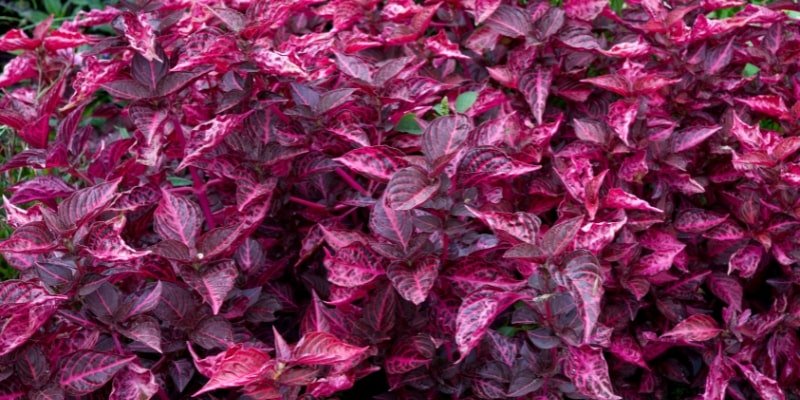 Scientific Name: Fittonia albivenis ‘Red Anne’
Scientific Name: Fittonia albivenis ‘Red Anne’
Plant Type: Perennial Herb
Geographic Origin: Brazil, Bolivia, Colombia, Ecuador, Peru
Plant Size: 4-6
Water Needs: Moderate to Heavy
Sun Exposure: Partial Shade
You can use a plant calculator to figure out how much water a plant needs, but not all plants allow this. It comes out to the Red Anne to 8 cups every nine days without direct sunshine and nine glasses of direct sunlight every seven days.
The leaves of this plant also have red veins. Use well-draining soil, such as vermiculite or coconut coir, for optimum health and growth.
35. Polka dot ‘Carmina’
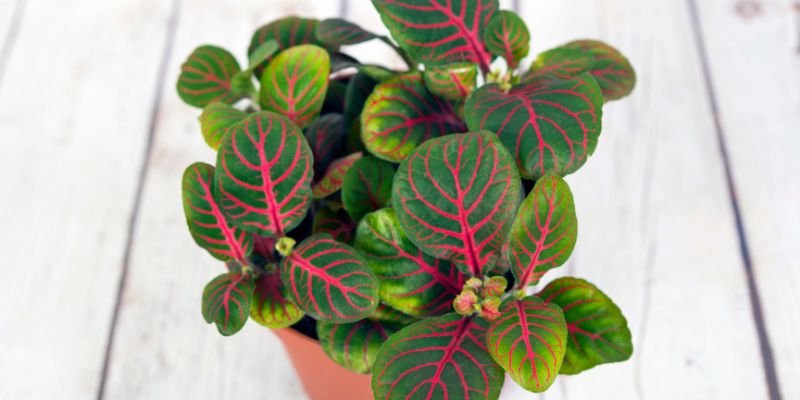 Scientific Name: Hypoestes Phyllostachya
Scientific Name: Hypoestes Phyllostachya
Plant Type: Perennial Herb
Plant Size: 6 -12
Water Needs: Moderate
Sun Exposure: Full Sun to Partial Shade
Geographic Origin: Southeast Asia
The lime-green leaves of the red form of Carmina have characteristic scarlet or pink blemishes on their ovate, curving leaves. For optimal drainage, select loamy soil and maintain moisture in anything below the top inch of soil.
36. Caladium Bicolor ‘Florida Red Ruffles’
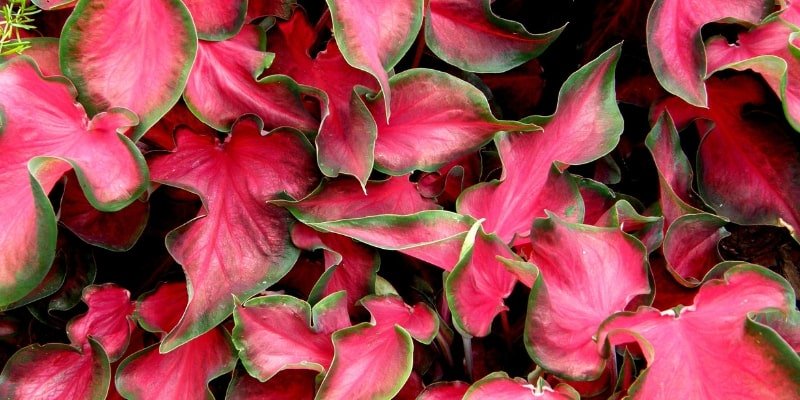 Scientific Name: Caladium Bicolor
Scientific Name: Caladium Bicolor
Plant Type: Tropical Perennial
Plant Size: 12-18
Water Needs: Moderate to Heavy
Sun Exposure: Full Sun to Part Shade
Geographic Origin: Latin America
The heart of the patent-pending Florida red rustle leaf is a striking shade of red, while the borders are green. These plants tolerate good sunshine and can be configured to produce earthy, sunny light in a room.
Do not continuously wet the soil; instead, water it regularly. Make sure the container has enough drainage capacity and is planted in good soil. This plant prefers drying out the soil in between watering.
37. Lance-Leaf Caladium
 Scientific Name: Caladium’ Red Frill’
Scientific Name: Caladium’ Red Frill’
Plant Type: Perennial Herb
Plant Size: 14
Water Needs: High
Sun Exposure: Shade/Partial Shade
Geographic Origin: Latin America
The vast, heart-shaped leaves of the Lance-Leaf have narrow green borders and a deep red coloration. A container or hanging basket filled with soil, such as peat, can allow for drainage. Water the soil as often as necessary to keep it moist.
38. ‘Confetti Blush’ Freckle Face Plant
 Scientific Name: Hypoestes Phyllostachya
Scientific Name: Hypoestes Phyllostachya
Plant Type: Perennial Herb
Plant Size: 6-12
Water Needs: Moderate
Sun Exposure: Partial Sun/Shade
Geographic Origin: Madagascar, South Africa
This plant features slender green leaves with reddish-pink dots commonly associated with freckles. It is ideal for small, shaded spaces. Well-draining soil is preferred for the roots to be moist but not overly damp.
39. Caladium Bicolor ‘Florida Sweetheart’
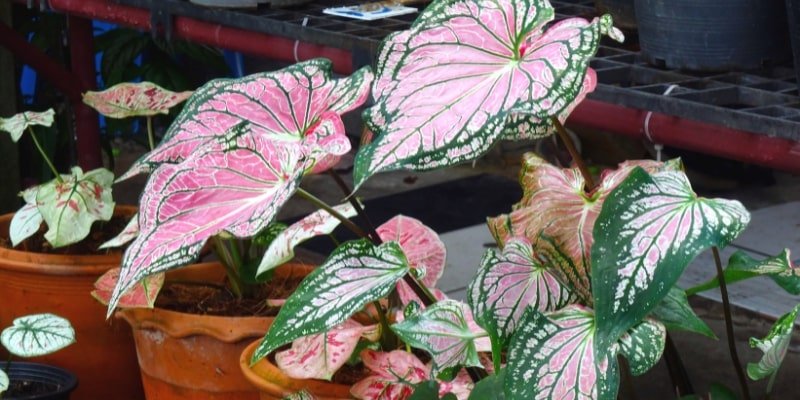 Scientific Name: Caladium Bicolor
Scientific Name: Caladium Bicolor
Plant Type: Herbaceous Annual
Plant Size: 12
Water Needs: Moderate to Heavy
Sun Exposure: Full Sun to Partial Shade
Geographic Origin: Latin America
The leaves of the Florida Sweetheart have smooth green borders with rose hues. The plants, which grow well in hanging baskets or containers, are known as “elephant ears.” Caladiums prefer loam soil.
Use a container that drains well. Maintain the plant’s temperature at least 70°F. Add liquid fertilizer about once a month.
40. Burgundy Ficus
 Scientific Name: Ficus elastica ‘Burgundy’
Scientific Name: Ficus elastica ‘Burgundy’
Plant Type: Broadleaf Evergreen
Plant Size: 6-10
Water Needs: Moderate
Sun Exposure: Bright, Indirect Light
Geographic Origin: India and Malaysia
As a houseplant, the Burgundy Ficus requires little maintenance. It needs a fair amount of water and plenty of indirect and bright light to thrive.
Its leaves are lustrous, thick, and dark green with crimson veining. As the plant ages and grows, its colour changes.
41. Creeping Inch Plant
 Scientific Name: Callisia Repens’ Pink Panther’
Scientific Name: Callisia Repens’ Pink Panther’
Plant Type: Forb
Geographic Origin: Mediterranean
Plant Size: 2-4
Water Needs: Moderate
Sun Exposure: Full sun to Partial Shade
This plant has a large number of tiny, ovals, pink-to-pinkish leaves. On ledges, the growth pattern is trailing and quite attractive.
Give the plant a spray to simulate dampness. Use soil that drains quickly, preferably with peat. Whether in a container or hanging basket, allow the soil’s surface to dry between watering.
42. Fittonia
 Scientific Name: Fittonia Albivenis
Scientific Name: Fittonia Albivenis
Plant Type: Evergreen Perennial
Plant Size: 6
Water Needs: High
Sun Exposure: Full to Partial Sun
Geographic Origin: South American Rainforests
There are photos of this plant that only feature green leaves. Fittonia argyroneura is the green leaf variant; it never has red leaves. Purchase Fittonia gigantea or Fittonia verschaffeltii to appreciate the leaves’ variegation of crimson to pink veins.
Fittonias are beautiful little animals that make their owners happy, but maintaining their health may be challenging. For instance, the soil needs to retain a pH of roughly 6.5 and drain well.
The ideal temperature is not less than 70°F, and they require humidity. If needed, mist the leaves with water. Maintain damp but not stagnant soil.
43. ‘Red Bull’ Begonia
 Scientific Name: Begonia Rex-Cultorum
Scientific Name: Begonia Rex-Cultorum
Plant Type: Evergreen Perennial
Plant Size: 6
Water Needs: Moderate to High
Sun Exposure: Full to Partial Sun
Geographic Origin: North Eastern India to China
The leaves of these houseplants are a deep red colour with hints of white along the veins. Purplish red, black splotches, and a reddish-brown border are possible colour variations.
The roots of these begonias might rot quickly. Give soil aeration your full attention and keep the soil damp but not so wet as to harm the plant. Use materials such as coconut coir to make soil that drains quickly.
44. Red Congo Philodendron
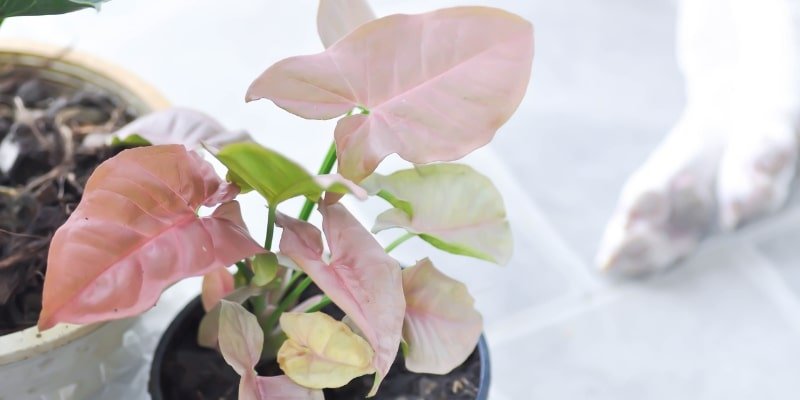 Scientific Name: Philodendron Rojo Congo
Scientific Name: Philodendron Rojo Congo
Plant Type: Perennial Herb
Plant Size: 5
Water Needs: Moderate
Sun Exposure: Full/Partial Shade
Geographic Origin: South America
If you are familiar with philodendrons, you might not think of the Red Congo when you link them with climbing or vining. This plant unfolds its long, broad, evergreen leaves like other plants do as it grows. The leaves have a calming, bright red hue while they are young, which fades with age.
Because it is heat- and cold-sensitive, this plant is an ideal adornment for your house. Perfect for this plant’s growing temperature range of 70º–80ºF, which is typically maintained by most people. Make sure the dirt in the container can drain easily.
45. ‘Red Star’ Nerve Plant
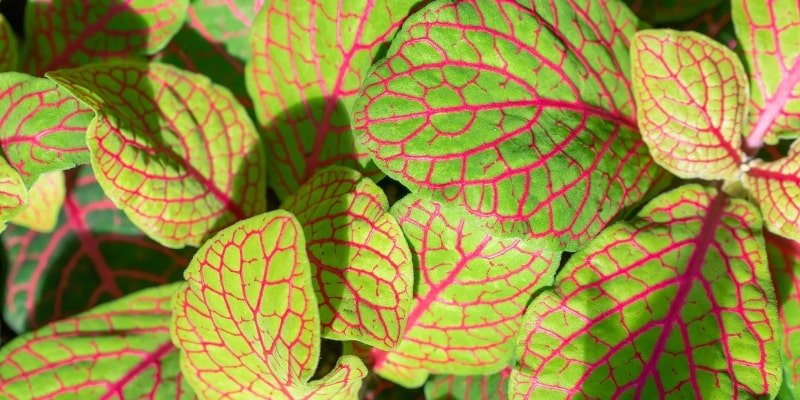 Scientific Name: Fittonia albivenis Red Star’
Scientific Name: Fittonia albivenis Red Star’
Plant Type: Perennial Herb
Plant Size: 12
Water Needs: Moderate to Heavy
Sun Exposure: Partial/Full Shade
Geographic Origin: Brazil, Bolivia, Colombia, Ecuador, Peru
The veins on several more Fittonia leaves give them a warm, red light. Not the Star of Red. All of the leaves, even the veins, are vividly pink to red. Maintain high humidity, just like with the other types.
Select loamy soil and make sure there is adequate drainage in the container. When checking the soil, add enough water to make it feel somewhat damp if the plant is not receiving direct sunlight.
Conclusion
You can choose the ideal red-leafed plant for any home, whether bright, shady, chilly, warm, hot, dry, or humid. If your ceilings are high, you can have a tall plant or a small plant to brighten a window.
Thus, if time is of the essence, you can choose from all these possibilities and get something low-maintenance. Most plants also purify our air, so add some red to your decor to make it look better!

